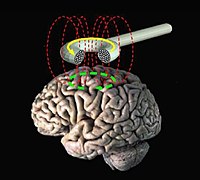
Photo from wikipedia
Transcranial direct current stimulation (tDCS) and transcranial random noise stimulation (tRNS) are two methods of noninvasively modulating cortical excitability below the placed electrode. Anodal tDCS over the cerebellum has been… Click to show full abstract
Transcranial direct current stimulation (tDCS) and transcranial random noise stimulation (tRNS) are two methods of noninvasively modulating cortical excitability below the placed electrode. Anodal tDCS over the cerebellum has been shown to modulate cerebellar brain inhibition (CBI), which is an indication of cerebellar excitability, but does not alter contralateral M1 excitability. However, the effect of tRNS over the cerebellum has not been investigated. The purpose of this study was thus to compare the effects of tDCS and tRNS over the cerebellum on CBI and the contralateral motor evoked potentials (MEPs), as well as on the relationship between CBI and contralateral MEPs. A total of 15 healthy subjects completed four-condition transcranial electrical stimulation (tES) interventions (anodal tDCS_1 mA, anodal tDCS_2 mA, tRNS, and Sham) on separate days. CBI and MEPs were measured using transcranial magnetic stimulation (TMS) before and after the 20 min tES intervention. For all conditions, there were no significant differences before and after tES in CBI or contralateral MEPs. In contrast, following tRNS, changes in CBI and MEPs were significantly correlated. No significant correlations were found in the other three conditions, indicating that cerebellar tDCS and tRNS have distinct effects on the relationship between CBI and contralateral MEPs. Taken together, these findings suggest that cerebellar tRNS may modulate the cerebellar to contralateral M1 pathway.
Journal Title: Journal of Clinical Neuroscience
Year Published: 2022
Link to full text (if available)
Share on Social Media: Sign Up to like & get
recommendations!